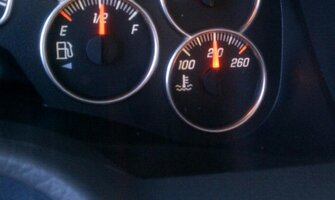- Dec 4, 2011
- 598
I've mentioned this in other threads, but I need some guidance trying to figure out my mileage problem. This has been going on for well over a year now, however I didn't have any solid info until recently. Essentially what is happening is that my gas mileage is virtually identical regardless if I run through a tank out on the highway or in town. Each tank that I've checked has been coming in between 15.2 and 15.8mpg. Last year I went for the easy fix and replaced my front oxygen sensor, however nothing changed. I considered the custom CAI, however the original one failed and I had to go back to stock for a few weeks until I could make a new one (of slightly different design). Again my mileage did not change. Even with the new steel front bumper, the readings are always in that range.
My best guess is that something is 'stuck'... maybe a bad sensor, maybe something else. Last time I checked readings from my ODBII (sitting in the driveway and revving the engine), I remember there were two fuel trims shown - one didn't change at all, and the other one only changed within +/- 0.1.
I want to hook the ODBII back up to the computer again and get some solid readings, perhaps tomorrow after I get home from work while the engine is hot, but I would like to have some clue as to what I am looking for, what I should be seeing, and what readings are important. If anyone can help me out on this, give me an idea of what is 'normal' while sitting in the driveway, I would appreciate it.
My best guess is that something is 'stuck'... maybe a bad sensor, maybe something else. Last time I checked readings from my ODBII (sitting in the driveway and revving the engine), I remember there were two fuel trims shown - one didn't change at all, and the other one only changed within +/- 0.1.
I want to hook the ODBII back up to the computer again and get some solid readings, perhaps tomorrow after I get home from work while the engine is hot, but I would like to have some clue as to what I am looking for, what I should be seeing, and what readings are important. If anyone can help me out on this, give me an idea of what is 'normal' while sitting in the driveway, I would appreciate it.

 )
) You definitely cannot use the DIC for accurate mpg, but it can give a rough idea of short-term changes. I know what ranges my DIC generally shows for certain types of driving, but all of the numbers I've given for mpg here were calculated by the tank. The other gauges, you just have to know how to read them. For instance, the oil gauge tells what the computer *thinks* the pressure should be, which is why it doesn't fluctuate much. The temp gauge should be roughly accurate -- a few degrees isn't going to hurt you, but it does give you enough information to know when there is an issue with the thermostat.
You definitely cannot use the DIC for accurate mpg, but it can give a rough idea of short-term changes. I know what ranges my DIC generally shows for certain types of driving, but all of the numbers I've given for mpg here were calculated by the tank. The other gauges, you just have to know how to read them. For instance, the oil gauge tells what the computer *thinks* the pressure should be, which is why it doesn't fluctuate much. The temp gauge should be roughly accurate -- a few degrees isn't going to hurt you, but it does give you enough information to know when there is an issue with the thermostat. After 17K miles, I never topped 230 miles and I always had 270-280 on the small tank. Sold the Kumhos early and went back to Michelin's and regained my mileage. Low rolling resistance tires make a huge difference...just a thought.
After 17K miles, I never topped 230 miles and I always had 270-280 on the small tank. Sold the Kumhos early and went back to Michelin's and regained my mileage. Low rolling resistance tires make a huge difference...just a thought.
